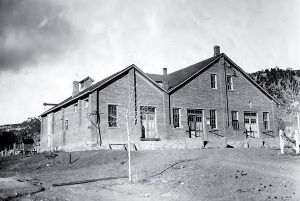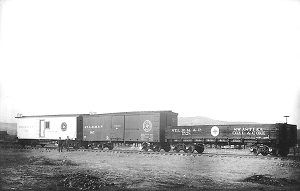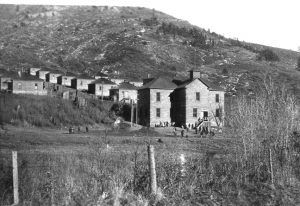The St. Louis, Rocky Mountain, and Pacific Company was incorporated in New Mexico on June 26, 1905. The northern New Mexico coal mining and coking company was organized by Henry and Hugo Koehler of St. Louis, Missouri.
Earlier that year, the company had bought out the Raton Coal & Coke Company, which the Maxwell Land Grant Company and the Santa Fe Railway owned, with each having one-half interest. The sale provided the buyers with title to 212,000 acres of land and coal rights to an additional 350,000 additional acres. The sale was called one of the most important coal and railway developments of New Mexico.
Almost immediately after the company was established, it bought or formed several subsidiary companies. One was the Swastika Fuel Company in Raton, whose purpose was to mine coal and other minerals and acquire mine lands and conduct mercantile business. It also took over the Blossburg Mercantile Company, founded in 1895 to buy and sell goods, merchandise, and land. This resulted in a complete lack of competition for goods in all of the coal camps.
The company’s holdings eventually encompassed an 800 square mile area of Northern New Mexico; it owned several mines and established “company towns.” Coal was produced at Koehler, Van Houten, Blossburg, Brilliant, Swastika, Gardiner, and Sugarite. Coking plants were operated in Gardiner and Koehler.
At one point, the company was the largest coal producer in the state, employing a daily average of 497 miners. The coal was marketed in Colorado, Kansas, Oklahoma, Texas, New Mexico, and Arizona.
To assure competitive rail service for their coal and coke traffic, the company opened the St. Louis, Rocky Mountain, and Pacific Railway Company in 1907. This rail line ran 120 miles, traversing the company’s holdings and linking to Raton, Cimarron, and Des Moines. It also connected with the Atchison, Topeka & Santa Fe, the Colorado and Southern, and the El Paso and Southwestern lines, transporting coal and agricultural products and timber of the area.
Hugo and Harry Koehler, Jan Van Houten, manager of the coal company, and Charles and Frank Springer, both previously active in the Maxwell Land Grant Company’s affairs, were active investors in the railroad.
Under the Swastika brand, the company’s coal was sold at retail, and the railroad was known as the Swastika Route. However, over time, the owners decided that the combination of the railroad business and coal business was too much to handle, and the railroad was losing money.
The railroad was sold to the Atchison, Topeka & Santa Fe on August 1, 1913. On March 10, 1915, the name was changed to the Rocky Mountain and Santa Fe Railway Company.
In the meantime, the St. Louis, Rocky Mountain & Pacific Company remained in the coal and other business. It remained a major force in the coal development of Colfax County until 1955, when it discontinued business.
The entire interest of the coal company was sold to the Kaiser Steel Corporation in 1955. Much of the land today is incorporated into the 923 square mile Vermejo Park Ranch.
© Kathy Weiser-Alexander/Legends of America, updated April 2021.
Also See:
Coal Mining Towns of the Vermejo Park Ranch
Railroad Companies in American History
Sources:
U.S. Depart of the Interior, Report of the Secretary of the Interior for the Fiscal Year 1907, Volume 2, 1907.
Myrick, David F., New Mexico’s Railroads: A Historical Survey, University of New Mexico Press, 1990.




